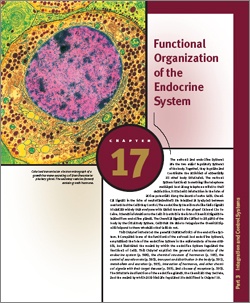
 | The nervous and endocrine systems are the two major regulatory systems of the body. Together, they regulate and coordinate the activities of essentially all other body structures. The nervous system functions something like telephone messages sent along telephone wires to their destination. It transmits information in the form of action potentials along the axons of nerve cells. Chemical signals in the form of neurotransmitters are released at synapses between neurons and the cells they control. The endocrine system is more like radio signals broadcast widely that everyone with radios tuned to the proper channel can receive. It sends information to the cells it controls in the form of chemical signals released from endocrine glands. The chemical signals are carried to all parts of the body by the circulatory system. Cells that are able to recognize the chemical signals respond to them whereas other cells do not. This chapter introduces the general characteristics of the endocrine system. It compares some of the functions of the nervous and endocrine systems, emphasizes the role of the endocrine system in the maintenance of homeostasis, and illustrates the means by which the endocrine system regulates the functions of cells. This chapter explains the general characteristics of the endocrine system (p. 584), the chemical structure of hormones (p. 585), the control of secretion rate (p. 585), transport and distribution in the body (p. 591), metabolism and excretion (p. 593), interaction of hormones, and other chemical signals with their target tissues (p. 593), and classes of receptors (p. 595). The structure and function of the endocrine glands, the chemicals they secrete, and the means by which activities are regulated are described in chapter 18. |